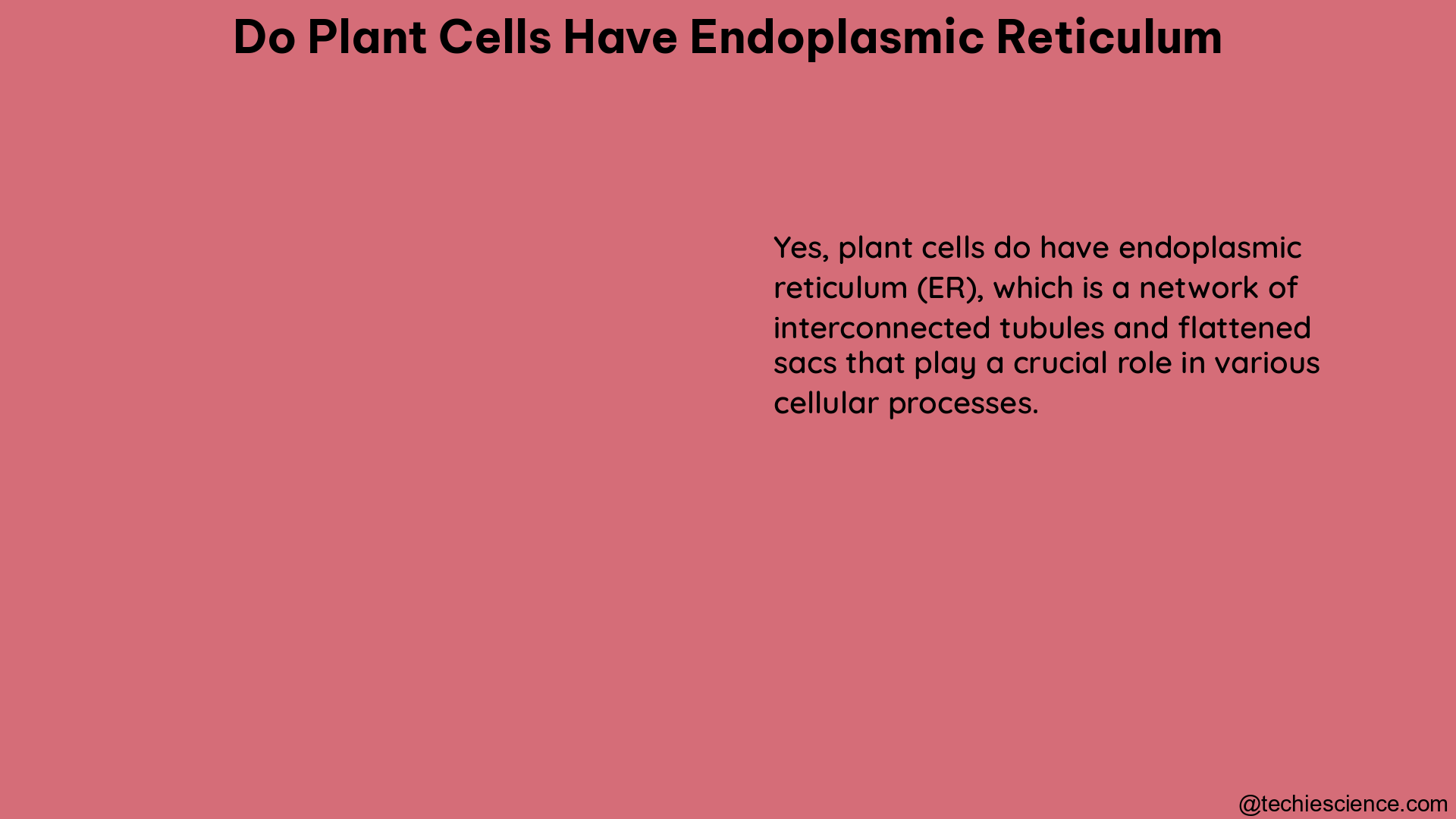Yes, plant cells do have endoplasmic reticulum (ER), which is a highly dynamic and complex organelle that plays a crucial role in various cellular processes. The plant ER is a polygonal membrane network composed of interconnected tubules and sheets (cisternae), forming the first compartment in the secretory pathway.
Structure and Composition of Plant ER
The plant ER is the largest membranous organelle in plant cells, pervading the cortex and endoplasm. It is continuous with adjacent cells through plasmodesmata, allowing for intercellular communication and transport. The plant ER is composed of the following key structural elements:
-
Tubules: The ER tubules are the predominant structural feature, forming a dynamic network that extends throughout the cell. These tubules have an average length of 2.78 ± 2.04 μm, a surface area of 7.53 ± 5.59 μm², and a volume of 1.81 ± 1.86 μm³.
-
Cisternae: The ER also contains flattened, sheet-like structures called cisternae, which are interconnected with the tubular network.
-
Junctions: The points where the tubules and cisternae intersect are called junctions, and they exhibit dynamic behavior, such as extension, shrinkage, closing, and opening.
The plant ER is composed of a variety of lipids, including phospholipids, glycolipids, and sterols, which provide the structural framework for the organelle. Additionally, the ER membrane contains a diverse array of proteins, including those involved in protein translocation, folding, glycosylation, quality control, lipid synthesis, calcium signaling, and metabolon formation.
Dynamics and Movement of Plant ER

The plant ER is highly dynamic, with rapid bulk streaming along actin cables. This movement is facilitated by the following mechanisms:
-
Tubule Extension and Shrinkage: The ER tubules can undergo extension and shrinkage, with an average junction velocity of 0.25 ± 0.23 μm/sec, ranging from 0 to 1.7 μm/sec.
-
Loop Closing and Opening: The ER network also exhibits the closing and opening of loops, contributing to the overall dynamic behavior of the organelle.
-
Actin-Dependent Streaming: The rapid bulk streaming of the plant ER is driven by its association with the actin cytoskeleton, which provides the necessary mechanical support and transport pathways.
The dynamic nature of the plant ER is closely linked to its cellular functions, as it allows for efficient transport, communication, and coordination between different cellular compartments.
Functional Roles of Plant ER
The plant ER is involved in a wide range of cellular processes, including:
-
Protein Translocation and Folding: The ER is the site of protein synthesis, translocation, and folding, ensuring the proper maturation of secretory and membrane-bound proteins.
-
Glycosylation: The ER is responsible for the addition of glycan moieties to proteins, a crucial post-translational modification that affects protein structure, function, and trafficking.
-
Lipid Synthesis: The ER is a major site of lipid biosynthesis, producing phospholipids, glycolipids, and sterols that are essential for membrane formation and function.
-
Calcium Signaling: The ER serves as a calcium store, releasing and sequestering calcium ions to regulate various cellular processes, such as signaling cascades and stress responses.
-
Metabolon Formation: The ER can form specialized microcompartments called metabolons, which facilitate the channeling of metabolic intermediates and the efficient operation of metabolic pathways.
-
Organelle Communication: The plant ER is in extensive association with endosomes, and some endosomes may be in physical contact with the ER, highlighting the importance of ER-organelle communication in plant cells.
Quantitative Analysis of Plant ER
Quantitative analysis of plant ER architecture and dynamics has been challenging due to its highly dynamic nature. However, recent advances in software tools have enabled the automatic extraction and quantification of ER tubules and cisternae from multi-dimensional fluorescence images. This has provided valuable insights into the structure, topology, protein-localization patterns, and dynamics of the plant ER, using spatial, intensity, and graph-theoretic metrics.
Conclusion
In summary, plant cells do possess a highly dynamic and complex endoplasmic reticulum (ER) that is involved in a wide range of cellular processes, including protein translocation, folding, glycosylation, lipid synthesis, calcium signaling, and metabolon formation. The plant ER is a polygonal membrane network composed of interconnected tubules and cisternae, and its structure, topology, and dynamics are closely linked to its cellular functions. Recent advancements in software tools have enabled the quantitative analysis of plant ER architecture and dynamics, providing valuable insights into this essential organelle.
References:
– Quantitative analysis of plant ER architecture and dynamics. NCBI. https://www.ncbi.nlm.nih.gov/pmc/articles/PMC6395764/
– Plant ER geometry and dynamics: biophysical and cytoskeletal control during growth and biotic response. Springer. https://link.springer.com/article/10.1007/s00709-016-0945-3
– Quantification of the Plant Endoplasmic Reticulum. CORE. https://core.ac.uk/download/pdf/40042766.pdf
– ER network homeostasis is critical for plant endosome streaming. Nature. https://www.nature.com/articles/celldisc201533
Hi, I am Sayantani Mishra, a science enthusiast trying to cope with the pace of scientific developments with a master’s degree in Biotechnology.